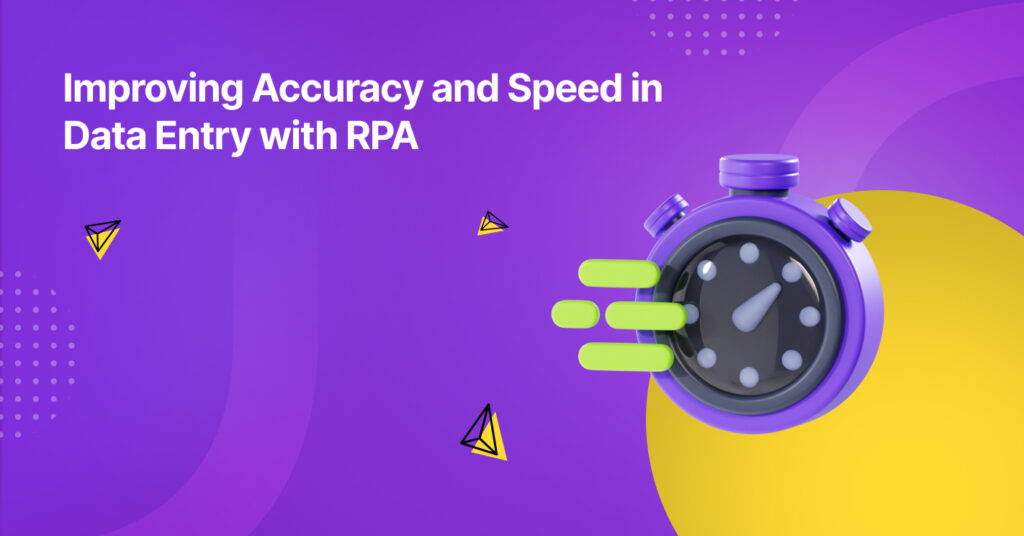The Hidden Cost of Manual Data Entry
Speed and accuracy are more than just operational goals; they’re essential to staying competitive. Yet, many companies still rely on manual data entry, a time-consuming and error-prone process that eats into productivity and drives up costs. Whether it’s transferring data from invoices, inputting customer records, or updating HR forms, these repetitive tasks can slow down operations and create unnecessary risks.
According to industry estimates, human data entry has an average error rate of around 1%. While that might seem minor at first glance, when multiplied across thousands of transactions, even small mistakes can lead to costly problems, including incorrect reporting, compliance issues, and lost trust.
Beyond Basic Automation
That’s where Robotic Process Automation, or RPA, comes into play. While many are somewhat familiar with RPA as a way to automate routine tasks, today’s version of RPA goes far beyond simple screen scraping or keystroke replication. Modern RPA solutions incorporate advanced capabilities, such as Optical Character Recognition (OCR), Artificial Intelligence (AI), and Machine Learning (ML). It means bots can now interpret
scanned documents, make decisions based on logic, and even learn from patterns over time. These intelligent bots are designed for speed and precision, making them ideal for managing high-volume, repetitive data entry tasks at scale.
Where RPA Makes the Biggest Impact
In terms of where RPA delivers the most value, some of the biggest gains can be found in areas like invoice processing, employee onboarding, CRM updates, and claims handling. In each of these processes, the steps are typically rule-based and repetitive, involving the transfer of data between systems, making them an ideal fit for automation.
For example, in finance departments, bots can automatically extract invoice data, validate it against purchase orders, and input it into accounting software with minimal human involvement. In HR, RPA can handle the tedious job of entering new employee information across various systems, ensuring accuracy and saving hours of manual work.
Customer service and sales teams also benefit, as RPA can keep CRM records current by pulling data from emails, forms, or third-party platforms. Even in insurance and healthcare, claims processing, which often involves reviewing forms and extracting key data points, can be handled faster and with fewer errors using automation.
Speed and Accuracy with RPA
The numbers speak for themselves. An article by Deloitte states that RPA solutions can improve data processing speeds by 60 to 80 per cent while achieving accuracy rates of up to 99.9 per cent. These aren’t just theoretical improvements. One mid-sized logistics company, for instance, may automate its invoice reconciliation process, reducing the time needed to handle 1,000 invoices from two days to just under four hours while eliminating almost all data entry errors.
The ripple effects were significant: not only were payments processed faster, but the finance team was also able to redirect their time toward more strategic planning activities.
The Broader Business Value of RPA
While efficiency is the most immediate benefit of RPA, the long-term value lies in how it transforms business operations more broadly. By taking over repetitive tasks, RPA frees up human employees to focus on work that requires critical thinking, creativity, or emotional intelligence. Improved data accuracy also enhances the quality of business insights, supporting better decision-making and more reliable reporting. In industries where compliance is key, having consistent and error-free data entry ensures smoother audits and reduces regulatory risks.
Furthermore, RPA plays a crucial role in digital transformation by helping to integrate legacy systems and automate workflows without requiring a complete overhaul of the IT infrastructure. It creates a bridge between disconnected platforms, making it easier for businesses to modernise without having to start from scratch.
Planning for a Successful RPA Implementation
Of course, implementing RPA requires thoughtful planning. Businesses looking to automate their data entry processes should begin by identifying areas that are high-volume, rule-driven, and prone to human error. It’s important to evaluate how current systems interact and determine whether they can effectively support automation. In some cases, simple adjustments to existing workflows can pave the way for seamless bot deployment. Choosing the correct type of bot is also critical. Some scenarios call for attended bots that work alongside employees, while others are better suited for unattended bots that run processes entirely in the background.
Managing Change and Building Buy-In
Changing management is another important consideration. Employees may initially worry that automation will make their roles redundant. Transparent communication and Training is key to helping teams understand that RPA is designed to automate the tedious aspects of their jobs, not replace them. In fact, many companies find that staff morale improves once the burden of repetitive work is lifted, allowing people to focus on more meaningful contributions.
A Smarter Way Forward
Ultimately, RPA represents a smart, scalable investment for businesses that want to improve operational performance without sacrificing quality. It allows organisations to do more with less, delivering faster turnaround times and fewer mistakes, while laying the foundation for digital transformation.
The beauty of RPA lies in its flexibility. Companies don’t have to automate everything at once. Starting small with a single data entry process can provide quick wins and prove the value of automation. From there, it’s possible to scale the solution across departments and even integrate it with broader enterprise systems.
For businesses seeking to boost efficiency, lower costs, and gain a competitive edge, the message is clear: rethink how data entry is done. Robotic Process Automation provides a pathway to increased speed, enhanced accuracy, and more effective utilisation of human talent.
Reach out to Mitrais to see how we can help your team incorporate RPA solutions into your business.






